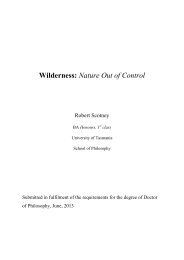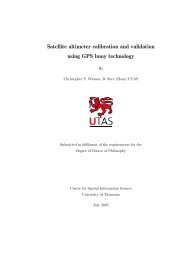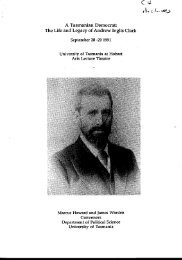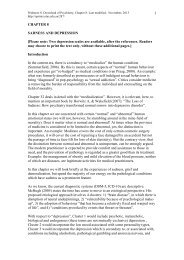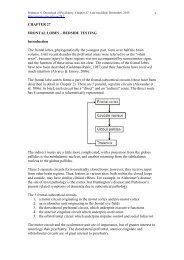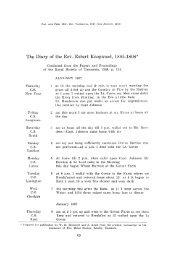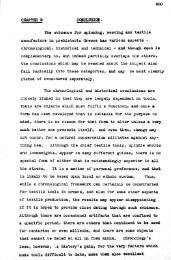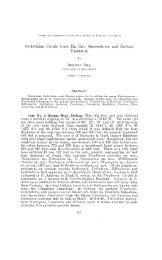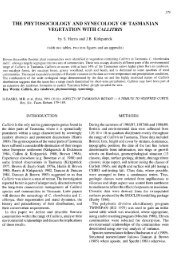Chapter 5 HALLUCINATIONS Hallucinations are ... - UTas ePrints
Chapter 5 HALLUCINATIONS Hallucinations are ... - UTas ePrints
Chapter 5 HALLUCINATIONS Hallucinations are ... - UTas ePrints
You also want an ePaper? Increase the reach of your titles
YUMPU automatically turns print PDFs into web optimized ePapers that Google loves.
Pridmore S. Download of Psychiatry, <strong>Chapter</strong> 5. Last modified: November, 2013.<br />
http://eprints.utas.edu.au/287/<br />
6<br />
suggested that people <strong>are</strong> more reluctant to talk about smells than voices, and that this<br />
type of hallucination may be more common than is generally accepted.<br />
Autoscopic (self see) hallucinations <strong>are</strong> the visual experience of the subject/patient<br />
seeing an image of him/herself (or parts of him/herself). This is a r<strong>are</strong> symptom which<br />
takes many forms, and is mentioned only as a curiosity – no student will fail an exam<br />
through unfamiliarity with autoscopic hallucinations.<br />
Brugger et al (1997) reviewed the literature and developed a classification containing 6<br />
types: 1) only parts of the double <strong>are</strong> seen (e.g., face, torso), 2) the double is complete<br />
(this is the “doppelganger” which appears in folklore and literature), 3) the feeling of a<br />
presence (no double is actually “seen”), 4) out-of-body experience (the individual is<br />
outside and looks back at their own body), 5) negative autoscopy (the individual is unable<br />
to see their own body either when looked at directly, or in a mirror), and 6) inner<br />
(internal) autoscopy (the inner organs <strong>are</strong> seen outside the body).<br />
Autoscopic hallucinations occur more frequently in neurological disorders (Dening &<br />
Berrios, 1994), but can occur in psychotic disorders and stressful situations.<br />
Illusions <strong>are</strong> perceptions that <strong>are</strong> associated with an outside stimulus, but the stimulus is<br />
wrongly interpreted. For example, lapping water may be heard as laughter. Technically,<br />
illusions <strong>are</strong> not hallucinations, because they <strong>are</strong> associated with a stimulus. Illusions <strong>are</strong><br />
frequently visual, and they <strong>are</strong> usually the result of a neurological disorder. The condition<br />
which most commonly causes illusions is delirium tremens (DTs), the disturbed state<br />
which can complicate alcohol withdrawal. Objects such as creases in bed covers may be<br />
perceived as snakes, insects or other animals. Folk law says that people in DTs see “pink<br />
elephants”. In clinical practice, however, small organisms <strong>are</strong> more commonly “seen”.<br />
Other perceptual difficulties include heightened and changed perceptions. By<br />
heightened perceptions is meant sounds seem unnaturally clear, loud or intense, colours<br />
appear more brilliant or beautiful, or details of the environment seem to stand out in a<br />
particularly interesting way. By changed perceptions is meant changes <strong>are</strong> perceived in<br />
the shape or size of people and inanimate objects in the environment. Changes may<br />
continue while the patient watches. These phenomena may occur in psychotic disorders;<br />
on occasions psychotic patients may be difficult to engage in conversation because they<br />
<strong>are</strong> concentrating on continuously changing perceptions. Patients may spend long periods<br />
looking in a mirror, watching their own face change. Heightened and changed<br />
perceptions may occur in other disorders, including the non-psychotic, anxiety disorders.<br />
Summary: Circumstances and disorders associated which hallucinations.<br />
<strong>Hallucinations</strong> <strong>are</strong> common in schizophrenia. They occasionally occur in the elevated<br />
phase of bipolar disorder and in very severe (psychotic) depression. The hallucinations of<br />
these mood disorders <strong>are</strong> usually auditory. In the elevated state, voices usually state that<br />
the individual has extraordinary skills or beauty, in the depressed phase voices usually<br />
denigrate or accuse the patient of reprehensible acts.



